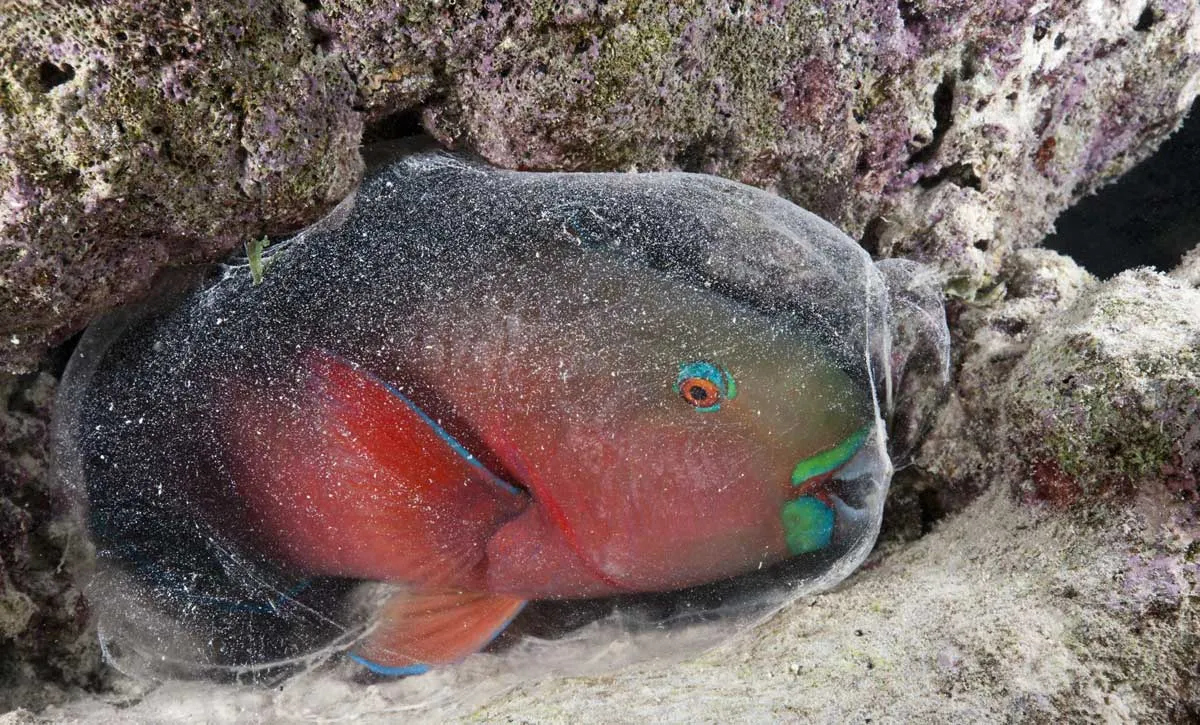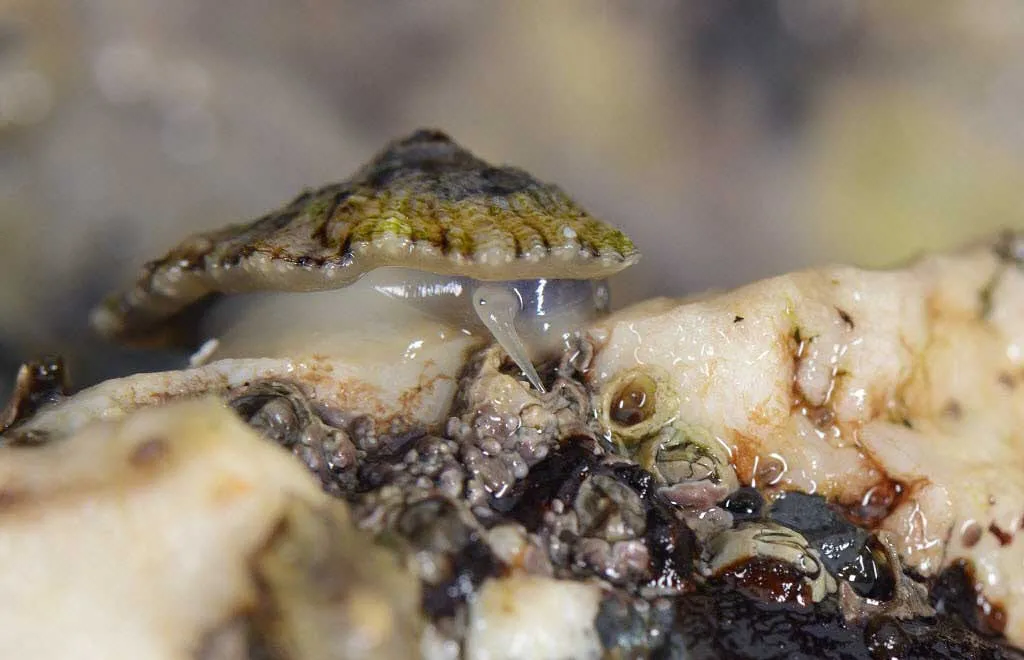On 13 July 2017, the apocalypse hit Oregon and it looked like an almighty sneeze. A lorry had overturned and dumped its gooey cargo on a section of Highway 101.
Slime covered the road surface, and a couple of vehicles got caught up in the gunk (see image above). And as if that wasn’t bad enough, the snot was teeming with hundreds of eel-like creatures: hagfish.
There are many outlandish life forms on the planet and then there is the hagfish. This ancient vertebrate tunnels its way through the carcasses of dead animals, feasting on their flesh.
It has no jaws, a double row of pointy teeth, and very simple eyes. Yet these peculiarities pale in comparison to the hagfish’s unique defence mechanism.
Stowed away in their skin are slime glands from which the hagfish release a slime precursor. This is made up of molecules called mucins, and long, tightly coiled protein threads. When released, the mucins bind with seawater and expand, while the threads unravel in milliseconds.
Together, they weave a textured slime that’s tough enough to gag a shark, clog its gills and scare it away. To stop itself becoming trapped in its own goo, the hagfish can tie a knot in its body and slide it from head to tail, wiping off the slime as it goes.
Why do animals need slime?
If the hagfish is the champion of slime, the rest of creation comes in a close second. Microbes, plants, fungi and animals all use, produce and need slime for protection and defence, to move and mate, to communicate and catch prey.
Even seemingly simple organisms have come up with ingenious slime solutions, whether they live on land or in the sea.
Velvet worms, for example, are slow creatures that walk on stubby legs. But they don’t need speed to catch their prey; instead, they’ll fire long streams of slime from cannons on each side of their head. The goo hardens so fast that there is no chance of escape.

Bola spiders favour a similar approach, but instead they swing sticky silk fibres to lasso their prey.
But slime isn’t just a trap, it can be a refuge as well. For example, when
a parrotfish wants a nap, it will secrete mucus from its gills, which it uses to form a cocoon around its body to keep parasites and predators away.
Slime can even be a home: edible-nest swiftlets build cup-shaped structures from their saliva that hardens to form a nest in which the birds can rear their chicks.
Read more:
- Slime moulds: 18 other-worldly photos of the puzzle-solvers without a brain
- Why do kids love slime so much?
Without slime, life on Earth clearly wouldn’t be the same. Yet there seems to be a woeful lack of research about slime.
One possible explanation is that slime is delicate and hard to study, and it operates mostly hidden from view, unless demand is high and production is ramped up until it spills over. Which begs one big question...
What exactly is slime?
According to retired German microbiologist Dr Hans-Curt Flemming, slime is just “stiff water”.
He sees biological slime not as a specific substance, but as a quality that materials can have. The characteristic ooziness is based on a particular structure, though. Biological slimes are so-called hydrogels. They consist of more than 95 per cent water that is bound in a 3D network of molecules. Slimes are basically just water in chains.
But those molecules that make up the remaining 5 per cent of slime make all the difference.
Pure water can be stirred without ever changing its behaviour. Slime, in comparison, is neither fully solid nor liquid but somehow both at the same time. And it’s adaptable too. The right kind of mechanical stress can change its behaviour and properties, making it more liquid or solid.
Frogs know how to use this when they hit prey animals with their long tongue. Their saliva liquefies on impact, running into every cranny on the prey’s body. Once the tongue pulls back, the saliva becomes viscous and stickier. The hapless prey is firmly glued to the tongue and forced to bungee jump right into the frog’s mouth.

The molecules that give slime these properties are called ‘mucins’, and they are evolutionarily ancient. All animals – from jellyfish to frogs, from snails to fish, from birds to mammals – use them in their bodily goo.
Mucin molecules vaguely resemble a bottlebrush, with an elongated protein acting as the handle, and sugar chains called glycans as the bristles. These glycans bind to water and help make slime.
How your body uses slime
Slime is often found at interfaces where organisms are exposed to the environment. In the human body, for example, mucus coats the surfaces of the airways, and the digestive and genital tracts.
These parts of our bodies are entry points for things like respiratory gases and nutrients, but are also vulnerable to potentially harmful particles and microbes.
Mucus, here, offers the first line of defence. As a barrier, it beats back germs. As a filter, it chooses what to admit into the body. And the mucus in the colon has one more job: it houses trillions of beneficial microbes, the gut microbiota.

How do you fight off pathogens while also accommodating hordes of microbes? You compartmentalise.
Researcher Prof Gunnar Hansson at the University of Gothenburg is an expert on all things mucus. He has shown that the mucus in the colon has two layers.
The first layer lines the tissue and is a formidable barrier to all microbes, be they beneficial or harmful. The mucus on top of that is more welcoming: a home for the microbiota.
Hansson’s work has proved how sophisticated goo can be – and how our bodies live in peaceful coexistence with a multitude of microbes. “This was a real breakthrough in the field,” Hansson says.
And there’s another breakthrough on the way. Prof Katharina Ribbeck, a scientist at MIT, has analysed the interactions between the glycans on the mucin molecules and microbes.
She has found the same pattern in the mouth, the lungs and the gut: mucus domesticates microbes. The glycans keep the microbes in check, preventing them from becoming too numerous or dangerous.
The weirdest ways animals use slime
It’s impossible to say when life first started using slime, but it happened very early in our evolutionary history.
Flemming speculates that the first microbial cells might already have used it, either naturally occurring gels or ones they produced themselves. What we do know is that for billions of years, life on Earth consisted only of microbes with goo.
Microbial slimes are incredibly resilient and have at times dominated the whole planet, covering all habitats in a gooey blanket. Their prominence as a feature of life hasn’t gone unnoticed by scientists who try to figure out what aliens might look like.
“We will find life on other planets,” says zoologist Dr Arik Kershenbaum at the University of Cambridge.
“It will happen soon and it’s going to be slime. I think it’s extremely likely that there will be planets with microbial life. And I think it’s extremely likely that they will live in interacting communities.”

Complex multicellular aliens, on the other hand, are a remote possibility and we shouldn’t hold our breath. But why look elsewhere when we have the most outlandish creatures right in front of us? No alien could be more bizarre than the snails on our planet, who are blessed with the most versatile goo.
Scientists were baffled for a long time how snails manage to crawl, with only one foot? Why, they surf on a wave of slime, of course.
Muscular contractions run like waves across the bottom of the snail. They press on the slime underneath a specific region on their foot, until the slime’s inner structure collapses. The mucus liquefies and the snail can glide over this specific spot. Once the wave has passed, pressure is relieved and the framework can rearrange. The slime hardens enough for the snail to push off.
Read more:
But as well as helping the snail to move, the slime also acts as a message board. Snails can read each other’s slime trails and find mating partners. Who crawled here? Can I mate with them? Where did they go? So many messages, and they’re all written in slime.
These bold cries for love can fall on the wrong ears, though. Or a mouth, in the case of the rosy wolfsnail. This carnivorous snail has turned its upper lip into an elongated slime scanner that can sniff out the trails of potential snail prey as well as more familiar tracks of mating partners.
Limpets, however, will use their own slime trails to find their way home. They leave their resting spot – their ‘home scar’ – to graze the algae off rocks when the tide is high, and follow their own trails back home when the tide goes out, using the slime they left behind as a ‘trail of breadcrumbs’.

How slime could be used in future technology
There is hardly a question in nature that doesn’t have an answer in slime, and the tangled web of slime biology is difficult to unravel. Still, if we can fully harness the desirable qualities of slime, such as its superb stickiness, then it could be useful for applications in manufacturing, medicine and future technology.
For instance, slime could help us make specialist adhesives. Most glues often fail to work underwater, are toxic, or won’t adhere once they’ve dried out.
Many animals, especially in the sea, solved these problems a long time ago. They can stick fast on any wet surface for any length of time and just as easily move on again – or reactivate old glue.
The common limpet, for example, is impossible to pry off rocks, while sea stars’ tiny feet leave dots of weak glue that can readily be dissolved.
Birgit Lengerer at the University of Innsbruck has studied the sticky slimes of marine creatures, and she certainly sees their potential for technical and medical uses. “With a non-toxic adhesive, we wouldn’t have to sew up surgical wounds,” she says.
One day we might even wear slime. Scientists around the world are trying to develop new, eco-friendly textiles based on hagfish slime. Even lighter bulletproof vests are seen as an option.
And that’s not all: the US Navy currently lacks an efficient and safe way to stop other boats in their tracks. Hagfish slime might do the trick and make the sea stay still instead – by turning water into goo.
About our experts
Dr Hans-Curt Flemming is a retired microbiologist. Up until 2014, he was the head of the Biofilm Centre at the University of Duisburg-Essen. He is currently a visiting Professor at the Singapore Center for Life Sciences Engineering.
Dr Arik Kershenbaum is a researcher at the department of zoology at the University of Cambridge. His work has been published in journals including Current Zoology and Methods In Ecology And Evolution.
Dr Birgit Lengerer is a post-doctoral researcher at the University of Innsbruck’s department of zoology. She studies biological adhesives, particularly the sticky slime of marine creatures. Her work has been published in the Biological Reviews Of The Cambridge Philosophical Society and Molecular Ecology journal.
Read more: